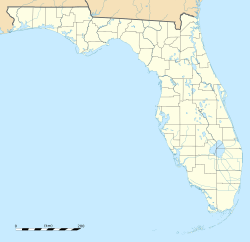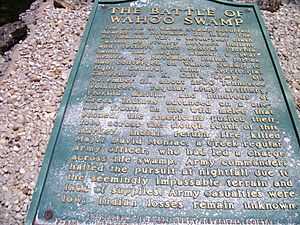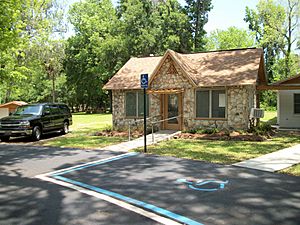Wahoo, Florida facts for kids
Quick facts for kids
Wahoo, Florida
|
|
|---|---|
| Country | |
| State | |
| County | Sumter |
| Elevation | 49 ft (15 m) |
| Population
(2012)
|
|
| • Total | 2,673 (estimated) |
| • Density | 854.2/sq mi (336.1/km2) |
| Time zone | UTC-5 (Eastern (EST)) |
| • Summer (DST) | UTC-4 (EDT) |
| ZIP code |
33513
|
| Area code(s) | 352 |
| FIPS code | 12-12119 |
| GNIS feature ID | 294963 |
Wahoo is a small community in Sumter County, Florida, United States. It's not an official city, but a group of homes and businesses. Long ago, the Timucua people lived here, followed by the Seminoles.
During the Second Seminole War, Wahoo was a safe place for the Seminoles. Many battles happened nearby. After the war, new settlers came and built a busy town. Today, Wahoo is a quiet, rural area connected to Bushnell. The battle site is now protected by Florida to help nature thrive.
Contents
Wahoo's History
What's in a Name?
No one knows for sure where the name "Wahoo" came from. The word "wahoo" isn't from native languages. English settlers started using it around 1770. It came from the Muskogee word "vhahwu." Some historians think the town was named after "wahoo trees," also known as winged elms, which grew in the area.
Early People of Wahoo
The Timucua tribes were the first people in the Wahoo area. They formed a group called the Paracoxi Confederacy, led by Chief Paracoxi. In 1539, a Spanish explorer named Hernando de Soto passed nearby. Sadly, his visit brought diseases like malaria, which killed many Timucua people. The survivors moved to St. Augustine. Later, during the Queen Anne's War, Colonel James Moore attacked Timucua villages.
Between 1767 and 1823, members of the Upper Creek Seminole tribe settled here. Many arrived after the Creek War of 1813-1814. Before this war, the Creeks were upset about America expanding onto their lands. The Upper Creeks, also called Red Sticks, fought against their own council and against Americans. The war ended in 1814, causing many deaths and destroying towns in Alabama.
The Second Seminole War
In 1824, the U.S. government signed the Treaty of Moultrie Creek. This treaty set aside the Wahoo Swamp area for the Seminoles. They started moving there soon after. However, the Seminoles became very dependent on government food because of a bad rainy season. This led the government to decide to move them to lands west of the Mississippi River.
Seminole leaders, like Osceola and Chief Jumper (who lived in Wahoo Swamp), did not want to move. At the same time, white settlers moved onto Seminole lands, breaking the treaty. People also tried to capture black Seminoles, even if they were free.
As tensions grew, Seminoles near Fort King moved their families to Wahoo Swamp for safety. In late 1835, General Duncan Clinch planned to attack the Seminole families in Wahoo Swamp. He wanted to force them to agree to the Treaty of Payne's Landing. He ordered soldiers to move from Fort Brooke (near Tampa) to Fort King (near Ocala).
General Clinch also gathered volunteers and soldiers at his plantation. Meanwhile, Seminole men moved their women and children to another village. The men stayed behind to fight.
After Dade's Battle on December 28, 1835, the soldiers and Seminoles returned to Wahoo Swamp. On December 29, General Clinch led his 710 men toward the swamp. Their guides led them to a deep part of the Withlacoochee River. Osceola and Abraham, a freed slave who helped with treaties, led 280 Seminole and black Seminole warriors. They ambushed Clinch's men as they crossed the river. This was the Battle of the Withlacoochee River. Clinch's men charged, and the Seminoles retreated into the swamp.
More battles happened in the area. In October 1836, General Call tried to destroy a village but had to stop due to lack of food. On November 13, 1836, Call and his men found the village empty and burned it. On November 21, Call's men met 620 Seminole and black Seminole warriors. The Seminoles fought back and then retreated into the swamp. Call's men did not want to cross the deep water. David Moniac, a soldier, was killed in this battle. Captain William Seton Maitland, for whom Maitland, Florida is named, was badly hurt and died later.
In 1841, Lieutenant C.R. Gates found three hidden villages in the swamp. They had cornfields and areas for processing coontie plants. On January 25, 1842, soldiers captured two Seminoles. Two soldiers were hurt, and one was killed. Another battle happened on February 12, 1842, where one soldier was killed and another injured.
Wahoo After the War
Many white settlers moved to Wahoo from other states in the mid-to-late 1800s. They found that the Wahoo Swamp area was great for growing sugar cane. They settled in five communities: Gum Slough, Bay Hill, Hay's Ferry, Wahoo, and Weed's Landing. Between 1846 and the 1890s, Wahoo had a Baptist church (still there today), stores, and a sawmill.
In 1994, there was a plan to change Wahoo's fire department from Bushnell to Nobleton. Wahoo residents protested because they preferred the Bushnell fire department. Bushnell had a plan to build a local fire station to respond faster to calls.
To protect the Battle of the Wahoo Swamp site, the Sumter County Historical Society asked the state of Florida for help in 2002. Florida agreed to protect the 850-acre site. It was added to a list for its amazing variety of plants and animals.
Geography and Climate
Wahoo is located at 28°41′26″ N and 82°11′44″ W. It is about 49 feet (15 meters) above sea level. The town of Bushnell, Florida and Interstate 75 are about 6 miles (10 km) to the east. County Road 48 runs through Wahoo.
North of the battle site is the Jumper Creek Wildlife Management Area. This area is part of the Withlacoochee State Forest. Wahoo is often considered part of Bushnell, Florida.
Wahoo's Weather
In January, the average low temperature is about 45.5°F (7.5°C), and the average high is 70.9°F (21.6°C). In July, the average high is 91.5°F (33.1°C), and the average low is 70.5°F (21.4°C). Wahoo gets about 50 inches (127 cm) of rain each year. It does not usually snow here.
Nature in Wahoo
Wahoo has four types of soil: Kanapaha, Ft. Green, Adamsville, and Sparr fine sands. These soils are not well-drained and are found in forest areas. They formed from ancient marine sediments. Underneath the soils is limestone.
The nearby Wahoo Swamp has areas of hardwood forests called "hammocks." These are surrounded by freshwater marshes and cypress swamps. The area has a rare limestone habitat that supports special ferns and orchids. Many similar habitats have been destroyed. The swamp is home to over 250 rare native plants, including many unique ferns and orchids.
People of Wahoo
In 2012, Wahoo had about 2,673 people. The average age was 52.4 years old. Most people in Wahoo (88.7%) are Caucasian. About 6.5% are African-American, and 4.0% are of Asian descent. About 0.9% are Hispanic or Latino.
Many residents have European backgrounds. The most common ancestries are Irish (19.7%), German (16.7%), and English (15.9%). Most people (94.8%) were born in the United States, and many (42.8%) were born in Florida. Most people (93.4%) speak only English at home.
Getting Around Wahoo
Most people in Wahoo (72.9%) drive their own cars, trucks, or vans to work. About 9.4% carpool. A small number (1.6%) use public transportation. Some people (8.0%) walk to work. The average time to get to work is 22.2 minutes. For library services, a "Libraries on Wheels" program stops at the Wahoo First Baptist Church.
Fun Things to See
The Wahoo Community Building and its grounds are a community center and a historical site. The building has two meeting rooms. The park around it has picnic tables and grills. The Wahoo Historical Monument is in the park. It has a plaque that tells the story of the Battle of Wahoo Swamp. This plaque was placed there in 1977.




